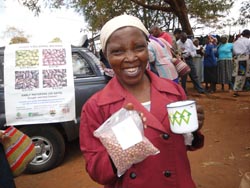|
New legume varieties are only useful if they reach the smallholder farmers who need them—and right now our track record is abysmal. The largest seed data set in the world (McGuire and Sperling, 2016) shows that smallholders currently source <1% (actually 0.6%!) of legume seed from the formal seed sector dealers – the channel most often supported by development programs. A whopping 65% (64.4%) of the seed sown comes from local markets, a venue we have not yet begun to harness to move our new varieties. Photo: Open market sales in central Kenya |
 |
So, along with seed supply development, novel delivery mechanisms are urgently needed to reach our varied clienteles. These include the malnourished, those seeking to improve their soil fertility and even farmers in stressed regions. We do, after all, claim that some of our varieties are suited especially for drought prone zones. Simple messages might help us break through what are especially conceptual barriers.
Simple message 1. Legume Seed is not Maize Seed. Farmers do not need to renew their bean seed season after season. They are looking first and foremost to buy new varieties, new germplasm. New business models are needed for the legumes. Business models that sell ‘germplasm’.
Simple message 2. Farmers are buying legume seed, and in huge quantity. It is a myth that farmers do not buy legume seed. In fact, 2/3 of the legumes smallholders sow are bought – season after season. For crops like common beans, seed purchases rise to over 80%. Hence, there is a massive market opportunity and customer base that needs to be captured.
Simple message 3. Moving to impact-oriented seed systems means Thinking SMALLHOLDER FARMER. Design features that actually cater to our client base include:
- Packing small. Allow farmers to buy seed (germplasm) 100, 250 g 500 g, 1 kg packages. Those interested to quantity can always buy multiple packages, or the occasional larger packs 5, kgs, 10 kgs.
- Going where farmers go. Mom and Pop stores can sell seed (Nigeria), supermarkets (Malawi), and even kiosks in local markets can reliably sell legume seed.
- Providing information systems that guide informed choices - and feedback. ‘Seeing is believing’, that is field demonstrations, are only part of the story these days. Text messaging, radio programs, phone video snips can all help create awareness and enhance demand. But remember that information should always be two-way. If something goes wrong, the seller needs to respond.
And surely there are other features. Some new businesses now bundle seed with other products, like micro-insurance, or fertilizer. Others are offering forward payment mechanism (via scratch cards), to help farmers incrementally save – so as to buy large volumes of seed.
In all of this, we ask "What is our goal?". It should be:
- To put on offer lots of LEGUME crops and varieties;
- To make sure they get to ‘the last mile’ geographically;
- To offer options that can reach the range of clientele, including the poor, the malnourished, and those facing tremendous climate variability.
Louise Sperling, Catholic Relief Services
McGuire, S. & Sperling, L. (2016) Seed systems smallholder farmers use. Food Security, 8, 179-195.
